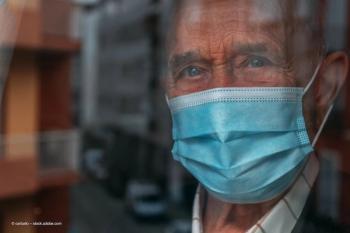
- Ophthalmology Times Europe July/August 2025
- Volume 21
- Issue 4
- Pages: 20 - 23
Starting from scratch on neovascular age-related macular degeneration
AMD treatment may become unrecognisable as gene therapies evolve
Luis Arias, MD, and Paolo Lanzetta, MD, recently found themselves on opposite sides of the debate table regarding the value of gene therapy to treat neovascular age-related macular degeneration (nAMD) at the 16th Annual Congress on Controversies in Ophthalmology, Seville, Spain. Dr Arias hails from the Retina Department of Ophthalmology at Bellvitge University Hospital in Barcelona and the University of Barcelona, Barcelona, Spain; Dr Lanzetta is from the Department of Ophthalmology, University of Udine, and the Istituto Europeo di Microchirurgia Oculare, both in Udine, Italy.
Arguing in favor of a bright future for gene therapy and nAMD
Despite the more recent attention to the potential of developing and using gene therapy to treat a number of different diseases, the concept of gene therapy was introduced more than a half century ago. In fact, clinical trials for ornithine transcarbamylase deficiency and X-linked severe combined immunodeficiency began in 1999 and 2002,1 respectively.
Skipping forward about 10 years saw the approval of the first in vivo gene therapy in Europe in 2012 and that in the US in 2017 and ex vivo products in, respectively, 2016 and 2017. As of 2022, numerous future products are in the works,1 Dr Arias recounted.
He envisions a bright future for gene therapy to treat nAMD in clinical practice. “Currently, we administer many intravitreal injections of anti-vascular endothelial growth factor [VEGF] drugs over time to treat nAMD. Gene therapies are a new therapeutic modality and the culmination of decades of research,” he said, which will streamline therapy of sight-threatening disorders and in many cases improve vision.
Approaches to gene therapy and delivery systems
The main methods involved in gene therapy are the addition of a gene2 by which genetic material is introduced into a cell to compensate for a missing or non-functional gene or to produce a therapeutic protein; editing of a gene3 to alter the sequence of an endogenous gene by targeted insertion, replacement or deletion of DNA base pairs; and alteration of a gene4-6 by delivering material to encode for an engineered RNA that modifies a cellular RNA target.
The available gene delivery systems offer a mixed bag of plusses and minuses,7 said Dr Arias. Use of a lentivirus provides higher capacity, transduction in diving/non-diving cells and low immunogenicity, but is hampered by low production yield, random integration and insertional mutagenesis.
Adeno-associated virus (AAV) does not cause any known diseases, induces a low immune response and provides long-term expression. Limited capacity is one downside. Long-term expression can be limited to post-mitotic cells. And there is risk of immunity, as 30% to 80% of the human population have antibodiesto AAVs.8
The most common vector used is AAV-8 since it is non-pathogenic and induces a low immune response and the delivered gene remains as an episome without integrating in the cell genome.
Use of adenovirus, which differs from AAV, provides a very large transgene capacity and high transduction in dividing/non-dividing cells; however, it provokes a strong immune response and the long-term expression is limited to dividing cells.
Finally, a non-viral gene system offers a low risk of both immunogenicity and insertional mutagenesis but is hampered by lower transfection efficacy and lack of persistent gene expression.
Focus on the eye
As of 2018,9 there have been more US trials investigating gene therapy for ocular diseases than any other bodily system because of the eye’s accessibility, well-defined anatomy, immune privilege, established proof of concept with approved products and measurable outcomes, said Dr Arias.
Ocular gene therapy can be administered into the subretinal space after performing a vitrectomy. Other potential routes of administration currently being investigated that do not require a surgical procedure are intravitreal and suprachoroidal injections.
Ongoing clinical trials have demonstrated that many patients with nAMD treated with gene therapy can control their disease with no supplemental injections over time. Importantly, gene therapy seems to be well tolerated with a good safety profile. This is in contrast to the visual outcomes of patients with nAMD whose vision decreased over time despite numerous injections of anti-VEGF therapy as seen in randomised controlled trials.10-13
The ABBV-RGX-314 (Regenxbio) phase 1/2a subretinal nAMD trial tested the safety and efficacy of the treatment in previously treated patients with nAMD. Five doses of the therapy were evaluated.14
The key takeaways of the trial were as follows: ABBV-RGX-314 significantly reduced the need for anti-VEGF injections in patients with nAMD. Patients maintained stable or improved vision and retinal anatomy for up to 4 years. A study on treating the second eye in patients with bilateral wet AMD showed a 97% reduction in annualised anti-VEGF treatment burden at nine months, with most patients being injection-free.
The treatment was generally well-tolerated with no drug-related serious adverse events reported in the fellow eye study. Mild, temporary adverse events included retinal pigmentary changes and conjunctival haemorrhage. Prophylactic steroids were not used in the fellow eye study beyond those typical for surgery.
The Atmosphere and Ascent trials, the phase 3 extension studies of ABBV-RGV-314, are currently ongoing and testing two doses of ABBV-RGC-314. These trials are evaluating the safety and tolerability of ABBV-RGV-314 compared with, respectively, ranibizumab (Lucentis, Genentech) and aflibercept (Eylea, Bayer).
“Gene therapy has the potential to transform the lives of patients through continuous treatment for both rare and common diseases,” Dr Arias concluded.
Arguing against gene therapy for nAMD
A big breakthrough in the treatment of nAMD was the introduction of anti-VEGF therapies in the early 2000s. The MARINA and ANCHOR studies15,16 evaluated the effects of monthly injections of ranibizumab 0.5 mg. The data showed that 91% and 98% of patients, respectively, were able to maintain their vision compared with sham treatment.
Skipping ahead after a plethora of studies of various anti-VEGF agents had been evaluated, the very recent PULSAR Study and extension trial17 found that aflibercept 8 mg improved treatment outcomes and provided sustained disease control in patients nAMD with extended dosing compared with aflibercept 2 mg.
The technology behind anti-VEGF drugs has evolved markedly from the initial results that prevented significant losses of vision to the present when patients can gain vision with the initiation of treatment. The future should promise a reduced treatment burden with preservation of vision and/or gains.18
Gene therapy delivery considerations
Regarding gene therapy, Dr Lanzetta sees a place for gene therapy but said now is not the time to adopt the technology as the standard of care because there are still too many unknowns.
In the context of the debate, arguing against gene therapy, he suggested that introducing gene therapy into the suprachoroidal space, rather than subretinally or intravitreally, is a feasible and efficacious route that is more acceptable because of the targeted access and broad transduction of the retinal cells observed in preclinical studies, compartmentalised AAV delivery and the minimal exposure to the vitreous and anterior segment. In addition, suprachoroidal delivery can be performed in an office setting.
He cited the phase 2 AAVIATE trial of ABBV-RGX-31419 in which the treatment was injected via the suprachoroidal route in contrast to the previously mentioned subretinal route. In this dose-escalation study that included 116 patients, the key outcomes were the best-corrected visual acuity,
ABBV-RGX-314 safety and tolerability, central retinal thickness and need for additional anti-VEGF injections. Analysis of three doses tested showed that the treatment was well tolerated and the highest dose resulted in the greatest reduction in treatment burden, with an 80% reduction in annualised injection rate. Additionally, 50% of eyes were injection-free. No intraocular inflammation developed in cases treated with a short course of prophylactic topical steroid eye drops.
While good results are being obtained, the appropriate dose has not been determined. Some patients lost vision likely because they received an incorrect dose, Dr Lanzetta explained, and some need anti-VEGF injections.
Ixo-vec (ixoberogene soroparvovec, Adverum Biotechnologies), formerly ADVM-022, is an AAV gene therapy that uses a vector capsid, AAV.7m8, that delivers aflibercept to the retina. The various studies have shown that the vision and central subfield thickness were maintained through 4 years and the treatment burden was reduced, but almost half of patients needed additional injection,20 he reported.
4D-150 (4D Molecular Therapeutics) is another gene therapy delivered intravitreally that seeks to both produce aflibercept in the eye and which promotes expression of aflibercept and inhibit VEGF-C. The treatment provides sustained improvement in vision without fluctuations. About 57% of patients were injection free; 83% enjoyed a reduced treatment burden. No serious adverse effects developed.21
Dr Lanzetta countered the proponents of gene therapy for nAMD, although he recognised the value of the approach in the future. “Viral vector gene therapy delivery is not the best choice. While the technology has enabled the first generation of commercialised gene therapy products, the next-generation therapies will require more complex engineering including multiple gene edits that will require a non-viral solution. The biggest industrial limitations with the viral vector approach are space in the viral capsid, cost, and inflexibility in manufacturing.”
Alternatives to viral vector gene therapy are available and include delivering genetic material to the cells via lipid nanoparticles, delivering DNA to tissues via electric currents, and plasmid-based gene therapy.
New technology
A new approach is laser-assisted optoporation, a non-viral gene delivery and expression of opsin encoding genes in mouse retina
in vitro and in vivo by use of pulsed femtosecond laser microbeam.22
Dr Lanzetta concluded, “Subretinal viral vector gene therapy delivery of anti-VEGF is not a viable therapeutic strategy for the management of retinal diseases.” He cited the following in his argument:
- Viral vector–based gene delivery “remains a rudimentary and constrained technology, with issues related to immunogenicity, vector capacity and manufacturing.”
- Subretinal administration is “invasive, requiring vitrectomy and retinotomy, with gene expression confined to the area of the bleb.”
- VEGF inhibition alone may be insufficient to address the complex pathophysiology of retinal diseases such as neovascular AMD, particularly via a single transgene product.
- Continuous, irreversible VEGF suppression “raises concerns for long-term ocular and systemic safety, including risks of RPE atrophy and treatment-related adverse effects.”
- Gene therapy cannot be halted, modified or reversed, even in the event of complications or lack of efficacy.
There is still an unfavourable risk-benefit-cost ratio for high-prevalence conditions like neovascular AMD, he stated.
Meanwhile, alternative pharmacologic therapies, including second-generation anti-VEGF agents, are demonstrating “improved durability, efficacy, and patient convenience,” and thus should remain in focus.
Paolo Lanzetta, MD | E: [email protected]
Lanzetta is affiliated with the Department of Ophthalmology, Istituto Europeo di Microchirurgia Oculare (IEMO), Udine, Italy. Lanzetta is a consultant for Adverum, Aerie, Allergan, Annexon, Apellis, Bausch & Lomb, Bayer, Biogen, Boehringer Ingelheim, EyeBio, EyePoint, i-Care, Genentech, Novartis, Ocular Therapeutix, Outlook Therapeutics and Roche.
Luis Arias, MD | E: [email protected]
Arias holds a position on the advisory board of AbbVie and lectures on behalf of the company.
Articles in this issue
4 months ago
Keys to optimising phaco efficiencyNewsletter
Get the essential updates shaping the future of pharma manufacturing and compliance—subscribe today to Pharmaceutical Technology and never miss a breakthrough.












































